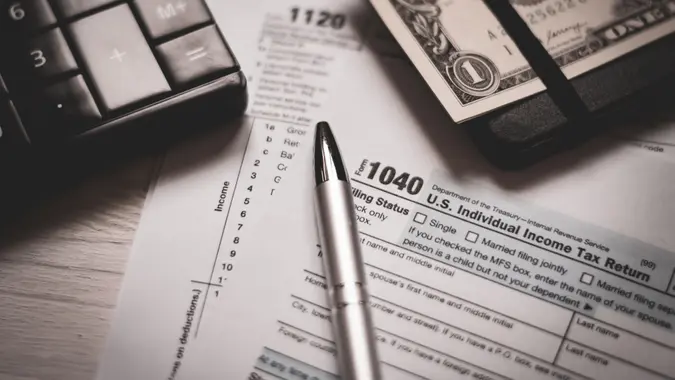Advertiser Disclosure
GOBankingRates works with many financial advertisers to showcase their products and services to our audiences. These brands compensate us to advertise their products in ads across our site. This compensation may impact how and where products appear on this site. We are not a comparison-tool and these offers do not represent all available deposit, investment, loan or credit products.
6 Tax Tricks the IRS Doesn’t Tell You
 Written by
Andrew Lisa
Written by
Andrew Lisa
 Edited by
Renee Ross
Edited by
Renee Ross

Commitment to Our Readers
GOBankingRates' editorial team is committed to bringing you unbiased reviews and information. We use data-driven methodologies to evaluate financial products and services - our reviews and ratings are not influenced by advertisers. You can read more about our editorial guidelines and our products and services review methodology.

20 YearsHelping You Live Richer

Reviewed by Experts

Trusted by Millions of Readers
Although April 15 is quickly approaching, there’s still time to file your taxes before this year’s deadline. As you work on filing your taxes, you may find yourself wondering if there are any IRS-approved “hacks” you should know about to save money.
GOBankingRates spoke with several tax professionals who offered their best strategies for lowering your bill and keeping as much of your money as possible. These tips can help you avoid expensive errors, maximize your deductions and lower your taxable income. Here’s what you need to know to get it right as the deadline draws near.
Double-Check Your Returns for Your Preparer’s Signature
This one might seem obvious, but you’d be surprised by how many people get into trouble because their accountants forget to include their signature. Your returns are ultimately your responsibility even if you get professional help, so always check that your preparer signed on the dotted line.
“Most people do not know that the tax preparer should have a PTIN, or Preparer Tax Identification Number,” said Miles Brooks, director of tax strategy at CoinLedger. “They should include it on the return and sign. Failure to sign can encourage scrutiny in the form of an audit and may result in you incurring a penalty.”
Subtract Your Reinvested Dividends
Savvy investors magnify their gains through DRIP, or dividend reinvestment plan. Instead of cashing out their dividend payments, investors on a DRIP put them right back in to add to their holdings, which then collect even greater dividends.
But the savviest of all remember them at tax time.
“Subtracting your reinvested dividends can save you thousands of dollars,” Brooks said. “While it is not a tax deduction, most taxpayers do not include it. If you have stock dividends and mutual funds and automatically reinvest the extra share, each reinvestment will increase your tax basis, reducing the taxable capital gain. So, not including the reinvested dividends means you will overpay your taxes.”
‘Bunch’ Multi-Year Deductions Into One Year
Today’s outsized standard deduction — $13,850 for single filers, $27,700 for married filing jointly — makes itemizing much less attractive. But an intelligent strategy could lower your taxable income enough to make it worth the extra effort.
One tax expert who spoke to GOBankingRates recommended ‘bunching’ deductions to exceed the thresholds. Bunching is defined as timing expenses by pushing deductible expenses into the same calendar year.
Harvest Capital Losses
The old adage with investing is that you don’t lose until you sell. While no one likes selling at a loss, doing so at the end of the year can reduce your taxable income — and therefore your tax bill. It’s called tax-loss harvesting.
“This involves selling investments that have lost value to offset capital gains from other investments, thereby reducing their overall tax liability in a year they anticipate more capital gains,” said Richard Lavina, CEO of Taxfyle. “For example, an individual may sell a stock that has declined in value, allowing them to offset capital gains from other stocks they’ve traded. This can be a smart move, as it reduces their tax bill and helps them rebalance their portfolio.”
If You’re Self-Employed, You Can Itemize on Top of the Standard Deduction
Many newly self-employed people don’t know they can take the full standard deduction and still write many of their biggest work expenses individually — including the dreaded self-employment tax.
But the write-offs don’t stop there. The IRS lets contractors and business owners deduct expenses related to their vehicles, continuing education, rent, advertising, work-related computers, Wi-Fi and more.
For a full list of approved deductions for individuals, visit the IRS.gov.
Families Have Free Tax Filing Options
Technically, this “is” a tax trick that the IRS does tell you. According to the IRS, there are several options available to families that want to file free federal tax returns.
And even better news: these options include online tax preparation, electronic filing and direct deposit of refunds for free. IRS Direct File, IRS Free File and MilTax are all options families may refer to ahead of the April 15 deadline.
More From GOBankingRates
Share This Article:




You May Also Like

I Asked ChatGPT What Would Happen If Billionaires Paid Taxes at the Same Rate as the Average Hawaii Resident
November 26, 2025
5 min Read


Here's How the One Big Beautiful Bill Will Impact Tax Returns in Every State
November 25, 2025
5 min Read



I Asked ChatGPT What Would Happen If Billionaires Paid Taxes at the Same Rate as the Working Class
November 24, 2025
5 min Read

I Asked ChatGPT What Would Happen If the Middle Class Paid Taxes at the Same Rate as Billionaires
November 25, 2025
5 min Read

I Asked ChatGPT What Would Happen If Billionaires Paid Taxes at the Same Rate as the Middle Class
November 21, 2025
5 min Read

Standard vs. Itemized Deductions: A Simple Guide To Choosing the Right Path
November 18, 2025
5 min Read



Trump Promised Tax Relief for Seniors -- Here's What Retirees Are Seeing Now
November 07, 2025
5 min Read

You Won't Believe Mark Cuban's Tax Bill -- Here Are 5 Tips To Keep Yours Much Lower
October 30, 2025
5 min Read
Make your money work for you
Get the latest news on investing, money, and more with our free newsletter.
By subscribing, you agree to our Terms of Use and Privacy Policy. Unsubscribe at any time.


Thanks!
You're now subscribed to our newsletter.
Check your inbox for more details.



Sending you timely financial stories that you can bank on.
Sign up for our daily newsletter for the latest financial news and trending topics.
For our full Privacy Policy, click here.
Looks like you're using an adblocker
Please disable your adblocker to enjoy the optimal web experience and access the quality content you appreciate from GOBankingRates.
- AdBlock / uBlock / Brave
- Click the ad blocker extension icon to the right of the address bar
- Disable on this site
- Refresh the page
- Firefox / Edge / DuckDuckGo
- Click on the icon to the left of the address bar
- Disable Tracking Protection
- Refresh the page
- Ghostery
- Click the blue ghost icon to the right of the address bar
- Disable Ad-Blocking, Anti-Tracking, and Never-Consent
- Refresh the page





